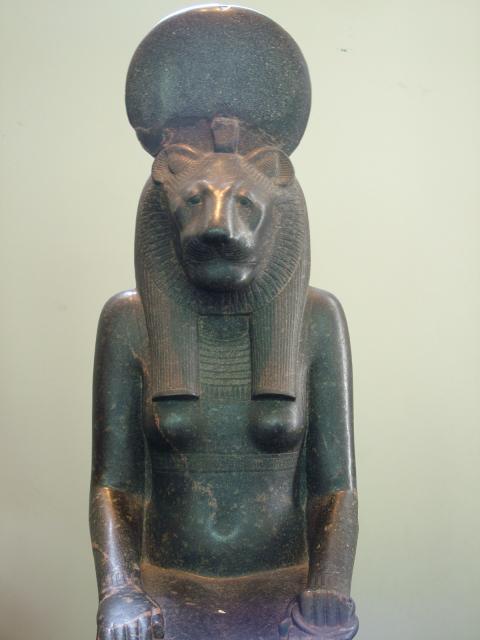Thinking how to start my first blog, I thought that the best place to start would be the beginning which is to say creation. However instead of starting out with the legends or myths of Osiris and Isis, because these are so well-know, it is endeavoured herein to introduce you, the reader, to a couple of other myths that are seemingly unknown to the casual reader. In the following paragraphs therefore, we shall summarise three myths or cosmogonies one of which comes from a stone made of basalt called the Shabaka Stone and finally from the Book of the Heavenly Cow, we shall see the rebellion of mankind.
 |
| The Shabaka Stone |
Of the three cosmogonies, the Memphite theology is where we shall start because it became the administrative and royal capital of the Old Kingdom. The Memphite theology, cited from the Shabaka Stone, (now in the British Museum) which is a stone made of basalt and dates to the 8th century b.c., informs us that the chief deity was Ptah and it was he, who, created the world through the thoughts and intentions of his heart and words; something the Greeks called the λογος. Here is a portion of the Shabaka Stone, courtesy of Ancient Origins, outlying the Memphite theology (www.ancient-origins.net):
“There took shape in the heart, there took shape on the tongue the form of Atum. For the very great one is Ptah, who gave [life] to all the gods and their kas through this heart and through this tongue,” and “For every word of the god came about through what the heart devised and the tongue commanded.”
 |
| The Memphite god Ptah |
Ptah was usually depicted in mummiform and carries a scepter with three very important symbols attached: the ankh (life), the was (power) and finally the djed (stability). Most of the time, though, this myth is paired with the Hermopolitan myth where Ptah is coupled with the Ogdoad.
In the Hermopolitan myth however, instead of the god Ptah create the world, it was Atum-Re who created the world. In this myth, there was something called the Ogdoad from another Greek word ογδοας which means group of eight. These eight gods, however, were counterparts of each other. They were Nun and Nunet (The primordial waters), Huh and Hauhet (formless) Kuk and Kuket (darkness), and finally Amun and Amunet (hiddeness) In a strange twist however, the men were depicted with heads of frogs and the women were depicted with heads of snakes. In some versions of this myth, the creator, Atum-Re, emerged from a lotus blossom and created the Ogdoad, others say he hatched out of an egg that the Ogdoad had created (www.egyptianmythology.org).
 |
| The Hermopolitan god, Atum |
This brings us to the final creation myth from Heliopolis. In the beginning, there was nothing but chaos or Nun which was black waters. Out of these black waters emerged what is called a Benben or Tatanen. At the same time arose Atum whose name means, "Everything and Nothing." Atum was a hermaphroditic deity encompassing all masculinity and femininity He stood atop the Benben, according to different versions, he sneezed, spat or masturbated thereby creating Shu (god of the air) and Tefnut (goddess of moisture). From these two gods, we have the Ennead from the Greek word εννεας which means group of nine (www.egyptianmythology.org).
Our final myth comes to us from a book entitled The Literature of Ancient Egypt by William Kelley Smith. Egyptologists, however, use the modern title, Book of the Heavenly Cow. This myth, however, has nothing to do with creation but rather the rebellion of humanity.The following excerpt is from the aforementioned book (Kelley, 2003):
Once it came to pass [under] the Majesty of Re, the self-generated god, that when he had been in the kingship over mankind and the gods combined, mankind proceeded to contrive a plot against the person of Re now that His Majesty, had grown old, his bones being of silver, his flesh of gold and his hair of genuine lapis lazuli. His Majesty became aware of the plot being contrived against him by mankind...
 |
| The goddess Sakhmet |
As one can see that the rebellion does not go unnoticed. Re goes on to summon the gods to inform them of the plot seeking advice as well. They inform him that he should send his Eye out to wipe humanity from the Earth. Interestingly, there is a play on words here for the word for mankind is rmt and the word tears is the word rmyt. Re has the goddess Hathor, in the form of his Eye go forth and kill humanity. Upon her return, Hathor informs Re that she has overpowered mankind and that she should hold off destroying them thereby creating Sakhmet. To conclude this tale of woe however, Re sends emissaries to fetch red ochre so that he can combine the red ochre with barely so he can make beer. The now Sakhmet, having seen the beer thought it was the blood of mankind. She quickly drank the beer and became drunk after which Re called her home. Thus was humanity saved.
In conclusion, each creation myth was unique in that they individualised the creation of the Earth and humanity. Each myth was special to their cities respectively giving authorship of the creation of the world to their gods. Finally, the rebellion of mankind really paints a picture of the wrath of Re when it comes to offending a deity so the next time you think it is a great idea to rebel against a god, think twice.
Kelley, William Simpson. 2003. The Literature of Ancient Egypt.
www.egyptianmythology.org



No comments:
Post a Comment